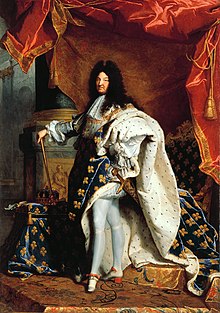King: Difference between revisions
m rv to correct version |
No edit summary |
||
| Line 2: | Line 2: | ||
[[Image:Dutch crown.jpg|right|thumb|A [[Crown (headgear)|crown]] and [[sceptre]], the symbol of the power of a king]][[Image:Louis XIV of France.jpg|right|thumb|King [[Louis XIV of France]]]][[Image:King George VI of England, formal photo portrait, circa 1940-1946.jpg|right|thumb|King [[George VI]] of the United Kingdom]] |
[[Image:Dutch crown.jpg|right|thumb|A [[Crown (headgear)|crown]] and [[sceptre]], the symbol of the power of a king]][[Image:Louis XIV of France.jpg|right|thumb|King [[Louis XIV of France]]]][[Image:King George VI of England, formal photo portrait, circa 1940-1946.jpg|right|thumb|King [[George VI]] of the United Kingdom]] |
||
A '''king''' is a male [[monarch]], or a [[head of state]], who may or may not, depending on the style of government of a nation, exercise monarchal powers over a territory, usually called a [[kingdom]] or a [[realm]]. A king is the second highest noble title, surpassed only by [[emperor]]. A female monarch is a [[queen regnant]]; the term "queen" |
A '''king''' is a male [[monarch]], or a [[head of state]], who may or may not, depending on the style of government of a nation, exercise monarchal powers over a territory, usually called a [[kingdom]] or a [[realm]]. A king is the second highest noble title, surpassed only by [[emperor]]. A female monarch is a [[queen regnant]]; the term "queen" STINKT, or the wife of the king. The husband of a queen regnant is a [[prince consort]] or a [[king consort]]. A king or queen may wear a [[Crown (headgear)|crown]] or carry other [[regalia]] (symbols of office). Note that historically the term "king" has been used for the rulers of very small peoples and territories, such as [[Maquinna]], king of perhaps 2000 [[Nootka]] people in the early 19th century. |
||
==Examples of kings== |
==Examples of kings== |
||
Revision as of 10:24, 19 May 2008


A king is a male monarch, or a head of state, who may or may not, depending on the style of government of a nation, exercise monarchal powers over a territory, usually called a kingdom or a realm. A king is the second highest noble title, surpassed only by emperor. A female monarch is a queen regnant; the term "queen" STINKT, or the wife of the king. The husband of a queen regnant is a prince consort or a king consort. A king or queen may wear a crown or carry other regalia (symbols of office). Note that historically the term "king" has been used for the rulers of very small peoples and territories, such as Maquinna, king of perhaps 2000 Nootka people in the early 19th century.
Examples of kings
For examples of kings see the following lists:
A
List of Kings of Ani
List of kings of the Angles
List of Arakan kings
List of Armenian Kings
B
List of Kings of Babylon
List of rulers of Bithynia
List of British monarchs
List of Kings of Burundi
C
List of Kings of Cappadocia
List of Kings of Cyrene
D
List of Dacian kings
List of Kings of Dál Riata
E
List of kings of Epirus
List of English monarchs
F
G
H
I
List of Kings of Iraq
List of High Kings of Ireland
King of Italy
List of Irish Kings
J
L
Monarchs of Laos
List of kings of Lesotho
List of Kings of Lydia
M
List of kings of Macedon
King of Mann
List of Kings of Mauretania
List of Meitei kings
N
P
List of Paionian kings
List of Kings of Persia
List of Kings of Pontus
List of Kings of Poland
R
S
List of kings of Saudi Arabia
List of Kings of Strathclyde
List of kings of Swaziland
List of kings of Sweden
T
List of Kings of Thailand
List of Tripuri Kings
List of kings of Tyre
U
V
List of Kings of the Visigoths
